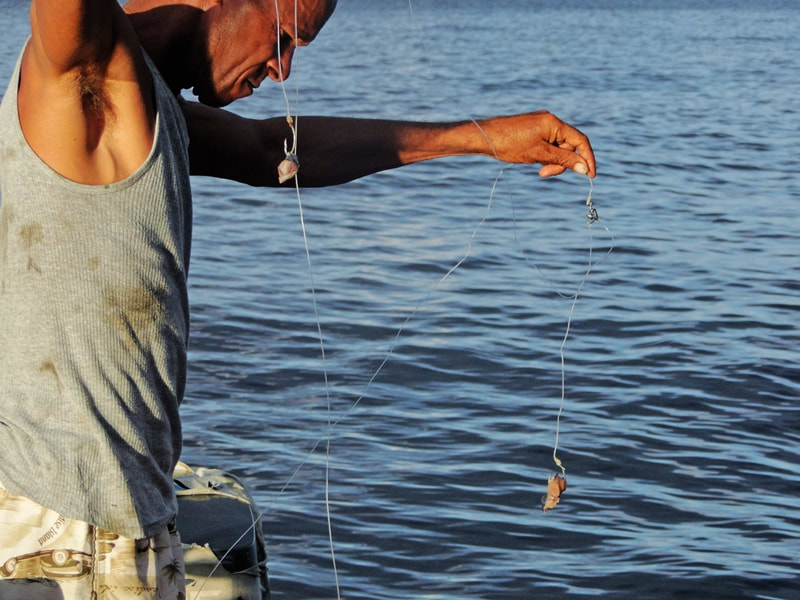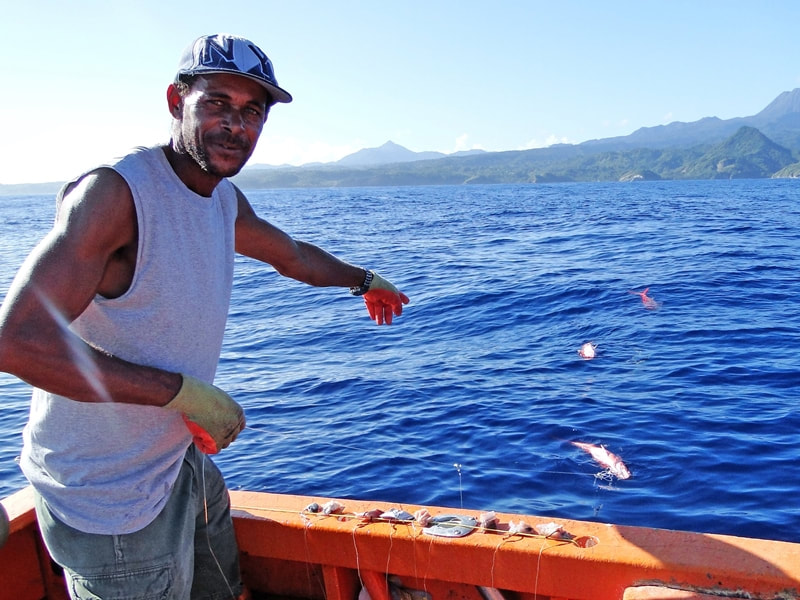Queen Snapper
Fishing for this variety of red snapper on Dominica is a challenging experience. These fish are most frequently caught at depths between 800 - 1000 feet.
As with tuna and marlin, local fishermen use only hand-lines in pursuit of these deep dwelling fish. The line rigging is not complex. At the very bottom of the main line a sinker weight is attached, perhaps a piece of 5/8" rebar a foot in length, attached by a light piece of string. This way, if the weight gets snagged on rocks, the fisherman can give a good tug, leaving the sinker behind and saving the line. Above the weight, 10 to 20 hooks are tied to 16 - 24 inch pieces of line. These short lines are then arranged approximately three feet apart along the main line just above the sinker. The bulk of the main line is wrapped around a piece of board or other item sufficient for wrapping a large length of line.
As with tuna and marlin, local fishermen use only hand-lines in pursuit of these deep dwelling fish. The line rigging is not complex. At the very bottom of the main line a sinker weight is attached, perhaps a piece of 5/8" rebar a foot in length, attached by a light piece of string. This way, if the weight gets snagged on rocks, the fisherman can give a good tug, leaving the sinker behind and saving the line. Above the weight, 10 to 20 hooks are tied to 16 - 24 inch pieces of line. These short lines are then arranged approximately three feet apart along the main line just above the sinker. The bulk of the main line is wrapped around a piece of board or other item sufficient for wrapping a large length of line.
Click any photo below to enlarge / view slideshow
To start fishing, the weight and hook portion of the line (the bottom 30-40 feet) is unwound and positioned along the gunwale of the boat; several hundred feet of the main line is then unwound onto the water surface as the boat moves forward at slow speed. This results in the line spreading well behind the boat.
The hooks are then baited with thumb sized pieces of salted bonito tuna. Next, the weight is dropped into the sea, the baited hooks zip overboard behind it on the way to the bottom. Finally, a buoy is tied at the top of the line and tossed overboard, allowing the line to drift with the current. By the time the second line is baited and deployed it is time to pull up the first line.
The hooks are then baited with thumb sized pieces of salted bonito tuna. Next, the weight is dropped into the sea, the baited hooks zip overboard behind it on the way to the bottom. Finally, a buoy is tied at the top of the line and tossed overboard, allowing the line to drift with the current. By the time the second line is baited and deployed it is time to pull up the first line.
|
Hand over hand over hand, mere feet at time, the fisherman pulls the line back into the boat, all of it piling on the floor of the boat. (shown below)
|
It is a time consuming process, one that wears on the muscles. Then, if snappers or a grouper have taken the bait, when the hooks are around 400 feet from the surface, the pressure change from the 900 foot depth affects the fish by blowing its air sack out from every orifice causing the fish and the line to float to the top. The fisherman keeps winding in the line often seeing the fish appear from below with many yards of line yet to be pulled.
Once at the boat's side, the fish are then removed from the line, hooks re-baited, weight dropped overboard, line in the bottom of the boat following. The fisherman repeats this process for hours, sometimes well into the night, nearly nonstop. Those who have done this can say they have seriously fished.... pulling 900+ feet of line, hand over hand, from sunup to well past sun down.
|










